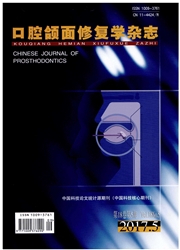

 中文摘要:
中文摘要:
目的:观察牙齿缺失对昆明小鼠空间学习记忆能力的影响.方法:90只成年雄性昆明小鼠随机分为上颌拔牙组和假手术组、下颌拔牙组和假手术组.术后8w采用Morris水迷宫做行为学测试.结果:拔牙组小鼠4d平均逃避潜伏期(上颌组:38.6±14.6s;下颌组:39.0±14.0s)明显长于假手术组(上颌组:29.0±19.7s;下颌组 29.1±18.6s)(P<0.01).拔牙组小鼠的第一次穿越平台时间(上颌组:13.6±3.3s;下颌组:13.1±4.3s)明显长于假手术组(上颌组:5.8±3.9s;下颌组:5.9±2.2s)(P<0.01).结论:磨牙缺失8w后昆明小鼠空间学习记忆能力下降.
 英文摘要:
英文摘要:
Objective: To investigate the effect of molarless on spatial learning and memory of KM mice. Methods: Ninety adult male KunMing (KM) mice were randomly divided into 4 groups: maxillary extraction group, maxillary sham group, mandibular extraction group and mandibular sham group. Eight weeks after the operation, the abilities of spatial learning and memory of mice in each group were measured using Morris Water Maze (MWM). Results: The results of the MWM test showed that as the mice were getting more training, the escape latency of each group gradually decreased, but the means of the four-day-escape latency for the extraction groups (maxillary: 38.6+ 14.6s; mandibular: 39.0+ 14.0s) were significantly greater than those for the sham groups (maxillary: 29.0+ 19.7s; mandibular: 29.1 + 18.6s) (P〈0.01). And the means of the time of ftrst passing the platform value for the extraction groups (maxillary: 13.6+ 3.3s; mandibular: 13.1+ 4.3s) were significantly greater than those for the sham groups (maxillary: 5.8+ 3.9s; mandibular: 5.9+ 2.2s) (P〈0.01). Conclusions: Eight weeks after molars loss, the abilities of spatial learning and memory of KM mice could be impaired.
 同期刊论文项目
同期刊论文项目
 同项目期刊论文
同项目期刊论文
 Increase of cytosolic calcium induced by trichosanthin suppresses cAMP/PKC levels through the inhibi
Increase of cytosolic calcium induced by trichosanthin suppresses cAMP/PKC levels through the inhibi 期刊信息
期刊信息
